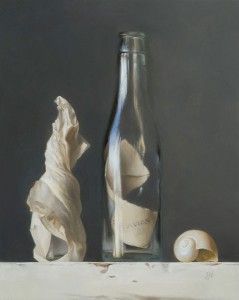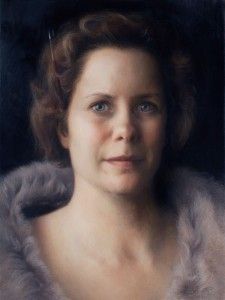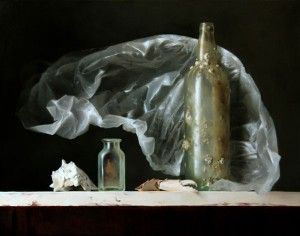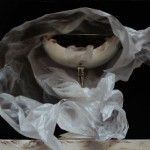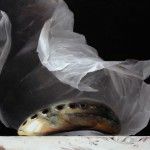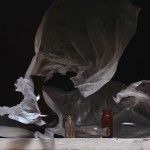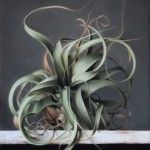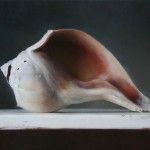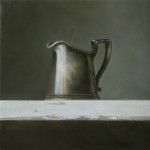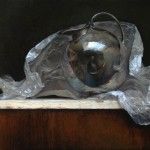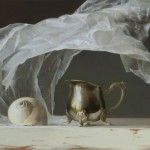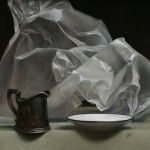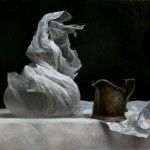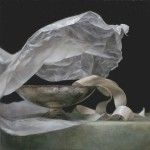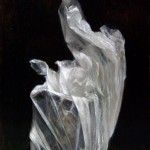For Sadie Valeri, the beauty is in the precise rendering of details
By Rosemary Carstens
“Often, articles about artists can make their lives look effortless, like they just woke up one day and started painting full time with zero strife, selling their work. But that is seldom true,” says internationally recognized still-life painter Sadie Valeri. About own her path to success she says, “I’d like to emphasize that not one step has been easy, and I work very hard every day to keep my art life going the way I need to.”
Valeri’s journey to accomplished painter was indeed a rocky one, strewn with years of struggle and self-doubt before she found her rightful place. From an early age she was enthusiastically encouraged by her parents, teachers, and friends and had every reason to think the art world was just waiting for her to arrive. She applied to the Rhode Island School of Design (RISD) in the late 1980s and was thrilled by her acceptance. Expecting something resembling her idea of a 19th-century atelier—which scarcely existed in the late 1980s—she soon found that the world of art she entered was a far cry from that romantic vision.
What she longed for was traditional training in realistic painting and drawing. The norm at the time was abstraction rather than figurative work—RISD’s painting department did not even have models. In the illustration department, Valeri was encouraged to disdain anything “commercial,” and all of her classmates aimed to be fine artists. “I worked hard and got good grades,” says Valeri, “and I assumed the universe would somehow pay me to be an artist.”
But that was not to be. Through most of her 20s and into her early 30s, Valeri gave up painting altogether. She felt so frustrated by the abstract expressionism she saw others creating, work that simply wasn’t her voice, and she felt like an outsider. Nowhere did she see people drawing and painting like the 19th-century artists she most admired. It seemed she was out of step; she questioned whether or not she was meant to be an artist after all.
During this period, Valeri worked as a designer and did not call herself an artist. She isolated herself from the art world, thinking painting would just be her hobby. But, in 2004, she had an epiphany. Following a frustrating attempt to paint from live models, she turned to the Internet and discovered the work of Michael Grimaldi, which was everything she’d imagined painting should be. He taught at the Bay Area Classical Art Academy, which offered training in the type of work Valeri longed to create. Signing up for a workshop with Juliette Aristides, Valeri finally found the teacher she had been searching for all along. It was a one-week drawing class, and, as she puts it, “it exploded my brain!”
Valeri started doing daily alla prima paintings but never felt they were finished. She began to slow down, to take as long as needed to complete a piece. At first this meant about 12 hours, but, as her work progressed, each painting took longer and longer. She chose still lifes as her subject matter but, because of how long her paintings took, she needed setups that wouldn’t wilt or decay. One day, she grabbed a piece of crumpled wax paper lying around her studio and added it to an arrangement. She spent 60 hours painting it, and, at the end, she knew she had found a material that would challenge and interest her for a long time.
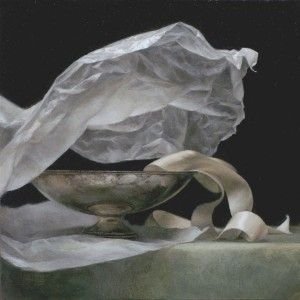
Wax Paper and Ribbon, oil, 12 x 12.
Valeri spends between 60 to 120 hours on a typical painting, roughly three to six weeks. She does not have multiple paintings going at once: “I find I become obsessed with each piece, and I don’t like to change gears. I keep thinking I’ll get faster, but instead my standards for myself keep rising—I see yet more I want to achieve and the paintings take, if anything, longer. While I’m working on my painting of the moment, part of my mind is thinking up new compositions, playing with rearranging materials on a big, long still-life shelf in my studio. You might say it’s an extremely slow-motion assembly line.” For Valeri, the exact translation of three-dimensional objects to the flat plane of her panels is a great joy. To be lost in that translation is her raison d’être.
When pressed, Valeri defines herself as a classical realist. She identifies her work as part of a continuing lineage from the Renaissance to 19th-century art, extended into the contemporary world. “I don’t see modernism as being a natural progression from the 19th century, but rather an intentional break from the past. That break has never interested me. I tried hard to like modernism, and I admire much of it for technique—expressionists can really move paint—but I’ve never wanted to paint abstractly. I notice a visual phenomenon and want to capture it in paint.”
And capture it she does. Valeri’s process is classic, found in the work of few artists living today. It begins with making her own gesso in a complicated process involving rabbit-skin glue, pigment, and marble dust; she coats each painting panel thoroughly, lets it dry, and then power sands it after each of three coats to create the extremely smooth surface she prefers.
With panels meticulously prepared, the underpinnings of each new painting are laboriously developed. Valeri begins by blocking in her subject matter on Mylar, where she resolves issues of proportion, shape, and composition. Next she transfers the drawing to her panel, refining every line and detail. Out of 100 hours she might spend on completing a painting, this initial step takes about 20 hours. Next she paints the entire composition in a transparent, open grisaille layer—a thin, monochromatic underpainting where only the darks are defined with paint and the lights are implied. This layer is painted in umber thinned with turpentine and takes about a day to complete. The open grisaille is followed by an extremely detailed, full-value layer using burnt umber, ultramarine blue, and titanium white, in which edges are kept soft. On top of all of these preparatory layers, she paints the entire composition all over again in opaque color. Since all technical problems or challenges have been resolved in the earlier stages, she can now focus on hue and chroma.
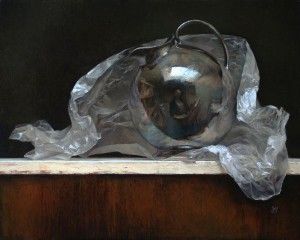
Silver Globe Pitcher, oil, 12 x 16.
A close look at UNDERSEA reveals the impressive results of Valeri’s painstaking process. Meandering through San Francisco’s historic North Beach one day, the artist spotted a large, barnacle-encrusted bottle in a shop window. The next day the bottle was perched on her still-life shelf, “quietly demanding to be painted.” Part of what makes this painting so interesting is how varied the objects are—related yet comprising a variety of edges and textures. When asked what drew her to this composition, Valeri mentions how the “waxed paper nearly disappears as it melts into the shadows of the background, while the spiny contours of the crab claw strike a dramatic silhouette. The soft, cool highlights of the glass bottle compete with the warm, sharp whites of the barnacle shells. The painting required the most subtle decisions about color, value, and edge control. It took many layers of thin oil paint to arrive at the final result—as many as seven to ten layers in the most complicated areas.”
Valeri keeps a busy schedule. She teaches two days a week and paints five, taking two months off from teaching during the summer and one month over the winter holidays, when she immerses herself in her studio. When not painting or teaching, the artist and her husband study Tai Chi. Valeri finds a resonance between this “precise, observant martial arts form” and her work as an artist. “Tai Chi,” she explains, “is about listening without filters, and painting is about looking without filters. Both require you to put everything else aside, so your mind and body can function at its highest sensitivity. Both require a lifetime of devotion.”
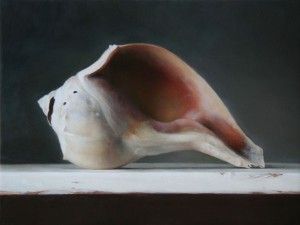
Conch Shell, oil, 9 x 12.
Awards and recognition of Valeri’s evocative artwork continue to mount, and her meticulously crafted depictions of transparent, crumpled wax paper in particular have attracted the highest honors, including First Prize for Still Life in the Art Renewal Center’s International Salon. She is a member of Hudson River Fellowship, Portrait Society of America, Oil Painters of America, and the International Guild of Realism.
“Sadie is the epitome of the new wave of realism in the world today,” says Maggie Kruger, owner of M Gallery of Fine Art in Charleston, SC. “Her work is sensitive, exquisitely rendered, and ever-evolving. When a collector purchased her painting of a conch shell recently, she said, ‘This is the most sensually rendered work I have ever experienced. It draws me in, makes me weep with joy. It is as if I have been visited by a Holy Presence both tender and eternally profound.’”
That profound beauty comes, in large part, from Valeri’s dedication to the details. Her persistent drive to perfectly render ordinary objects and to echo the dedication of the 19th-century masters is remarkable. Yet, she says, this is not the whole story: “I believe some of the nostalgia for that era is taken too far. As a modern realist, I draw on many traditional masters’ methods and try to echo their dedication, but I choose and depict different subject matter than they did. There is not just one way to be an artist!”
representation
M Gallery of Fine Art, Charleston, SC; Susan Powell Fine Art, Madison, CT; www.sadievaleri.com.
Featured in February 2012.
- Wrapped Silver Goblet, oil, 11 x 14.
- Auriform (Polished Abalone Shell), oil, 11 x 14.
- Black Jug, oil, 8 x 10.
- Bottle Collection, oil, 18 x 24.
- Casting Aspersions, oil, 12 x 9.
- Conch Shell, oil, 9 x 12.
- Message in a Bottle, oil, 10 x 8.
- Pewter Pitcher, oil, 8 x 8.
- Self Portrait at 39, oil, 16 x 12.
- Silver Globe Pitcher, oil, 12 x 16.
- Sterling Boat, oil, 9 x 12.
- The Wave, oil, 9 x 12.
- Undersea, oil, 16 x 20.
- Wax Paper I, oil, 11 x 14.
- Wax Paper II, oil, 11 x 14.
- Wax Paper and Ribbon, oil, 12 x 12.
- Wrapped Pewter Pitcher, oil, 8 x 6.






